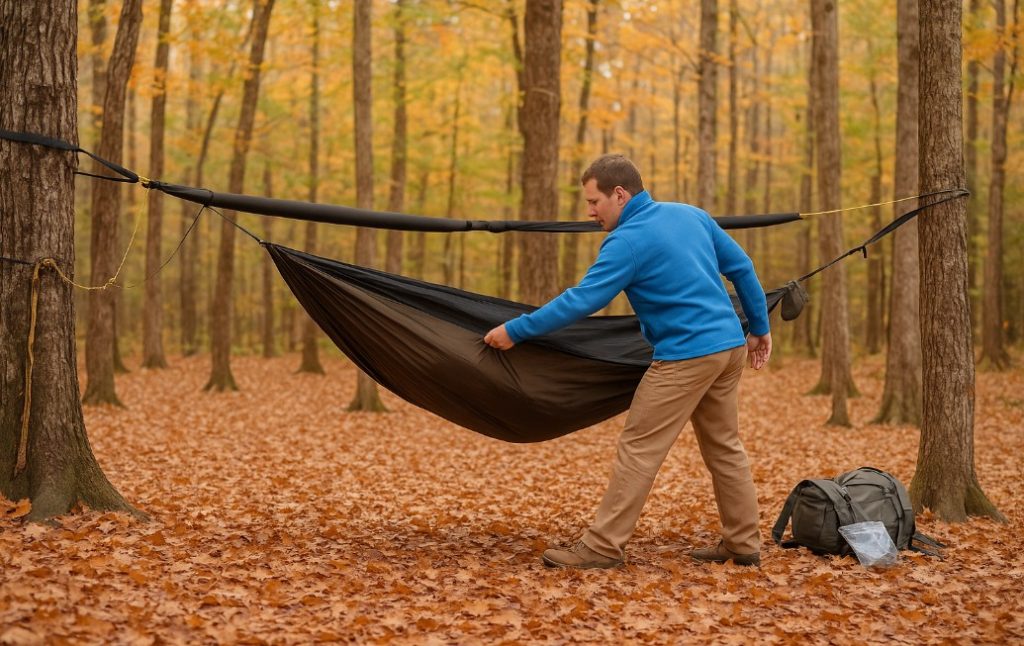There’s something magical about floating above the forest floor, swaying gently as the breeze rustles the leaves and birds call from the treetops. The world seems to slow down as you rock softly between two sturdy pines, cradled in your own pocket of peace.
Hammocks elevate camping from rugged to serene, transforming a simple overnight stay into a tranquil retreat among the trees. After a long day of hiking or paddling, nothing feels better than sinking into that suspended comfort, muscles unwinding as nature sings its lullaby.
Hammocks are the perfect lightweight camping gear, quick to set up, and keep you off the cold, uneven ground. No wrestling with tent poles or clearing rocks—just effortless relaxation.
And few things compare to stargazing from the cozy cradle of a hammock, wrapped in warmth as the wild hums around you, reminding you why you came.
Choosing the Perfect Hammock for Your Adventure

Finding the right hammock can make or break your camping experience. Consider size, material, and durability to match your style—whether you crave ultralight solo treks or roomy, luxurious lounging in nature.
Single vs. Double Hammocks: Which Size Suits You Best
Single hammocks are compact and featherlight, ideal for solo trekkers who prize portability. Double hammocks offer room to sprawl—or snuggle—but weigh a bit more, though they can also hold much more weight. If you crave elbow room or plan to lounge with a partner, a double is worth the extra ounces. And, as you can see above, a double makes a great choice for pet friendly glamping.
Materials That Matter: Lightweight Nylon vs. Cozy Cotton
Nylon hammocks dominate the camping scene for good reason—they dry fast, pack small, and resist mildew. Cotton, while plush and inviting, soaks up moisture and grows heavy after rain. For wild wanderings, stick to nylon. Save the cotton for lazy backyard lounging.
Weight Limits and Durability for the Great Outdoors
Every hammock has a weight rating, and exceeding it can lead to midair mishaps. Choose a model with sturdy stitching, reinforced seams, and robust suspension points. A well-built hammock will shrug off the stresses of wind, weather, and weary campers alike, as well as the aforementioned pet campers.
Essential Gear You’ll Need to Hang a Hammock
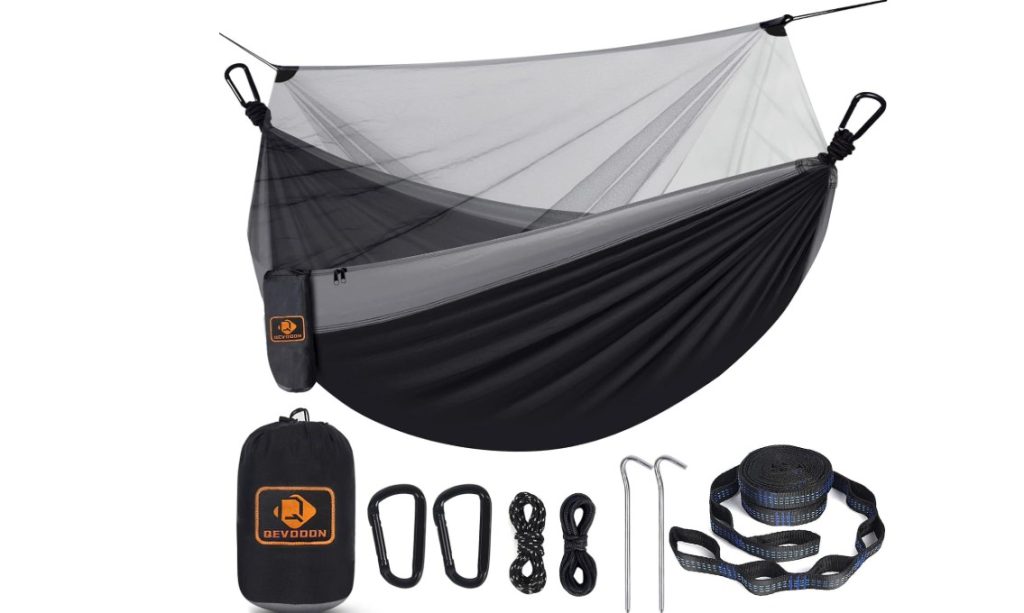
Before you can sway under the stars, you’ll need the right gear. From sturdy straps to clever carabiners, these essentials make hanging your hammock safe, simple, and stress-free. Most high-quality hammocks come with basic accessories like the hammock from Qevooon shown above, but they can also be purchased separately for replacement or to have more options on hand.
Tree Straps vs. Ropes: What’s Safest and Easiest
Tree straps are wide, flat, and gentle on bark. They grip securely without digging in, making them the eco-friendly choice. Ropes can cut into trees and slip under tension—save them for makeshift clotheslines, not your main suspension.
Carabiners, Toggles, and Whoopie Slings Explained
Carabiners clip your hammock to straps in seconds. Toggles are lightweight rods used in knotless setups, while whoopie slings are adjustable loops that fine-tune tension like magic. Together, these gadgets make hanging a breeze.
Optional Add-Ons for Extra Comfort and Convenience
Ridgelines hold gear and bug nets overhead, while gear slings stash your pack off the ground. A lightweight underquilt hooks beneath to keep your back toasty, even when the night air turns sharp.
Finding the Ideal Spot to Hang Your Hammock
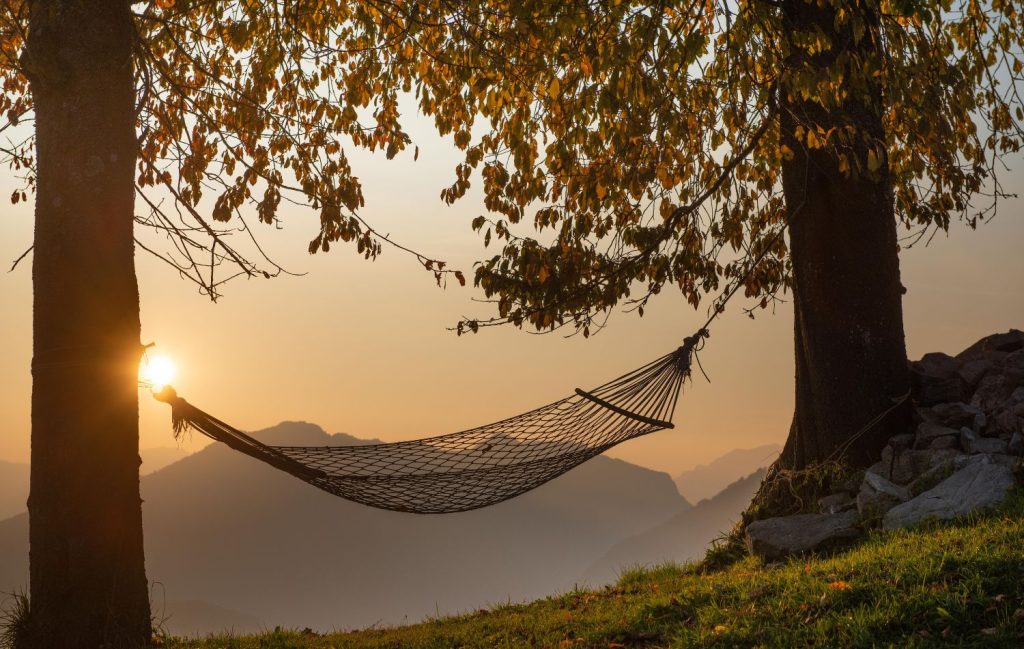
Choosing the right spot makes all the difference. Seek strong, well-spaced trees, breathtaking views, and a hazard-free zone to transform your hammock setup into a peaceful outdoor sanctuary.
The Perfect Tree Distance and Diameter
Look for trees 12 to 15 feet apart and at least 6 inches in diameter. Slim saplings won’t hold, and massive trunks may be too far for your straps. Aim for sturdy, mature trees that barely budge when shaken.
Avoiding Hazards: Dead Branches, Ant Trails, and Poison Ivy
Glance upward for “widowmakers”—dead limbs poised to drop. Scan the bark for insect highways and the ground for itchy intruders like poison ivy. A quick check could spare you a painful surprise.
Picking the Best View for Sunrise or Sunset Lounging
Half the joy of hammocking is the view — can you NOT picture yourself lounging in the hammock seen in the image above?? Angle your hang toward an open vista, a quiet creek, or a clearing where golden light spills through at dawn or dusk.
Comfort Hacks: Setting the Right Angle, Height and More…
Dialing in the perfect hang angle and height ensures your hammock feels weightless, stable, and blissfully comfy—keeping you safely suspended and ready for a dreamy night under the stars.
In the video above from Go Outfitters, discover clever tricks to make your hammock feel like a cloud—perfect angles, cozy layers, and smart gear setups that transform outdoor nights into dreamy, rejuvenating slumber under the stars. Additional details are provided below.
The Magic 30-Degree Hang Angle
A hammock hung too tight feels like a banana peel; too loose, and you’ll sag to the soil. Aim for suspension lines that meet the trees at about 30 degrees for a perfect balance of tension and comfort.
Ideal Seat Height for Easy Entry and Exit
Your hammock should hover around chair height—about 18 inches from the ground. This keeps you high enough to stay dry yet low enough to hop in gracefully.
Getting the Sag Just Right for a Flat Lay
A deep sag lets you lie diagonally, flattening your body like a floating bed. It may feel odd at first, but your spine will thank you by morning.
Diagonal Sleeping for a Flatter Lay
Angle your body diagonally across the fabric to banish the dreaded banana curve. This simple trick creates a flatter, comfier surface.
Pillow Placement and Blanket Bundling
A small camping pillow under your neck and a rolled blanket under your knees works wonders. Cocoon yourself and drift off as the crickets serenade.
Creating a Cozy Cocoon with Your Gear
Drape spare clothes along the sides as draft stoppers. Hang a tiny camping lantern from your ridgeline for a warm glow that makes your hammock feel like home.
Protecting Yourself from the Elements
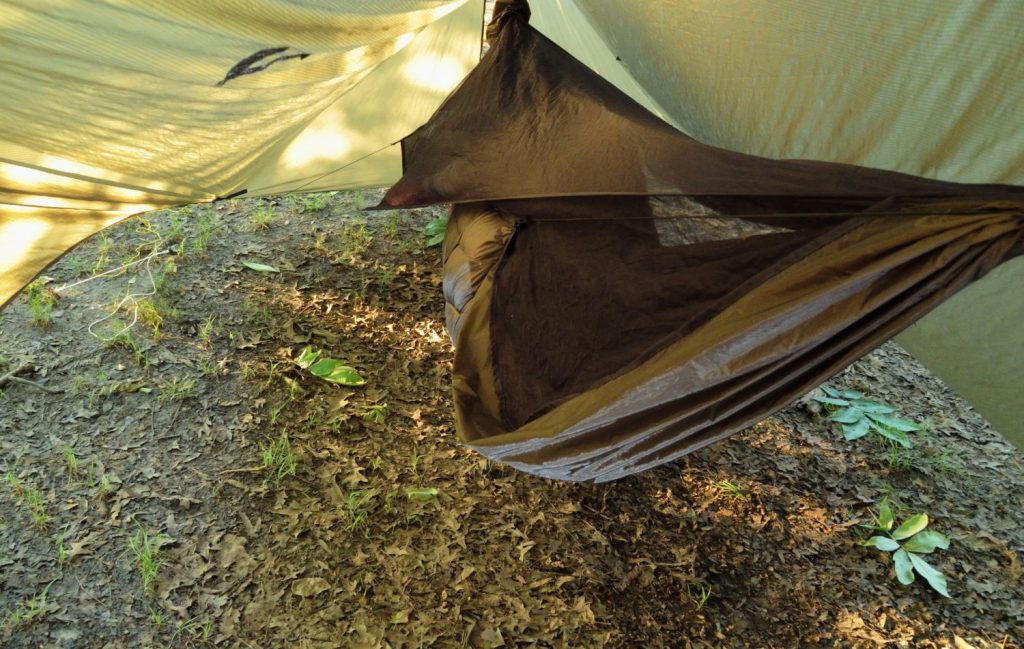
Stay dry, warm, and bite-free by shielding your hammock setup from nature’s surprises—rain, wind, cold, and insects—so you can rest easy no matter what the weather brings.
Adding a Rain Fly or Tarp for Stormy Nights
Stretch a waterproof tarp above your hammock at a slight angle so rain rolls off. A taut pitch and low edges create a snug fortress against sudden squalls.
Keeping Bugs at Bay with a Mosquito Net
A fine-mesh bug net draped over your hammock keeps winged tormentors at bay. Opt for one that zips shut and cinches tightly at the ends for a bite-free slumber.
Staying Warm with an Underquilt or Sleeping Pad
Cold creeps up from below, even in summer. A high-quality hammock underquilt wraps your hammock’s underside like a downy hug, while a foam or inflatable sleeping pad inside adds extra insulation.
Hammock Knots and Hanging Techniques
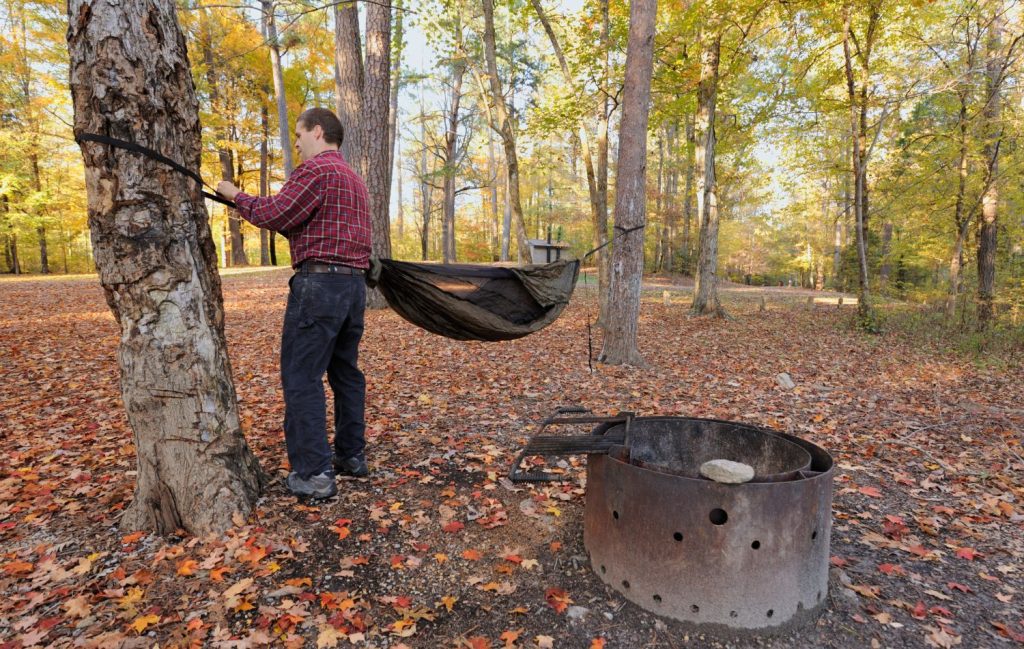
Mastering a few simple knots and smart suspension tricks ensures a secure, comfortable hang. Learn easy, tree-friendly techniques to set up your hammock safely and adjust it with ease.
Easy Knots Every Camper Should Know
A simple bowline or taut-line hitch can secure your setup when hardware fails. Master a few basic knots and you’ll never be stranded.
Using Tree-Friendly Suspension Systems
Modern strap systems with daisy-chain loops make hanging foolproof and bark-friendly. They eliminate knots, reduce friction, and distribute weight evenly across the trunk.
Quick-Adjust Tricks for a Perfect Tension
Slide buckles or whoopie slings let you micro-adjust your hammock’s pitch without untying a thing. A few tweaks can turn a wobbly hang into cloudlike bliss.
Safety Tips for Hammock Camping
Stay secure while you sway—these essential safety tips cover tree checks, weight limits, and smart nighttime habits to ensure your hammock camping adventure is as safe as it is serene. Be sure to check the terrific video above from Backcountry Exposure to learn even more about the intricacies and unexpected challenges that can arise while hammock camping.
Checking Tree Health Before You Hang
Give each tree a firm shake. If it sways, creaks, or sheds bark easily, move on. Healthy trees are your lifeline aloft.
Weight Limits and Safe Load Distribution
Never exceed your hammock’s listed capacity. Spread weight evenly between two anchor points to avoid stressing a single tree—or snapping a strap.
Nighttime Safety Tips for Peaceful Sleep
Keep camping essentials within arm’s reach: headlamp, water, and a whistle. Let someone know your location if camping solo, and zip into your bug net to avoid surprise visitors.
Leave No Trace: Eco-Friendly Hammocking
Protect nature while you relax. Discover simple ways to hang your hammock without harming trees, minimize your footprint, and preserve the wild beauty that makes camping magical for everyone.
How to Protect Tree Bark with Wide Straps
Use straps at least an inch wide to spread pressure and prevent bark damage. Your future hammock spots—and the forest—will thank you.
Packing Out Everything You Bring In
From snack wrappers to tent stakes, nothing should be left behind. Keep a small trash bag tucked in your pack to make clean-up effortless.
Respecting Wildlife and Other Campers
Stay quiet, camp away from trails, and avoid nesting areas. A peaceful presence preserves the wild magic for everyone.
Quick Troubleshooting Guide for 3 Common Hammock Problems
Even the best setups can hit snags. Learn how to fix saggy hangs, stop rain from sneaking in, and prevent wobbles or flips for a smooth, worry-free hammock experience.
- Fixing Saggy or Uneven Setups — If you’re sinking, tighten the suspension or shorten your ridgeline. Adjust one side at a time until your hammock floats evenly.
- Dealing with Rain Pooling on Straps — Add drip lines—a bit of cord tied on each strap—to divert rainwater before it sneaks into your hammock.
- Preventing Twists, Flips, and Midnight Spills — Keep your center of gravity low while entering. Sit first, then swing your legs in. Practice makes the wobble vanish.
Leveling Up Your Hammock Game
Take your hammock skills beyond the basics with creative upgrades, clever gear hacks, and pro-level setups that turn any campsite into a dreamy, elevated outdoor retreat worth savoring. Practice the hammock-building and hammock-hanging skills in these instructional videos and you can call yourself a true pro!
Building a Hammock Stand for Treeless Sites
Just one tree? No problem. DIY hammock stands let you lounge on beaches, meadows, and rocky outcrops where finding two perfectly situated trees is often not possible.
Turning Your Hammock Into a Rainproof Tent
With a full-coverage tarp, bug net, and underquilt, your hammock becomes a suspended fortress—a tent without the tent poles. Here’s one way to do it in just 60 seconds!
Creative Ways to Use Hammocks Around Camp
String a gear hammock for storage, a dog hammock for furry friends, or a communal lounging area strung between multiple trees. Campsite envy guaranteed. Here are 40 practical and fun ways to get creative with your hammock.
Relax, Sway, and Enjoy the View
Once your hammock is strung and snug, settle in. Let the gentle sway quiet your thoughts, the forest air refresh your lungs, and the stars become your glittering ceiling. Time slows as the world fades to whispers, and nature’s heartbeat thrums softly beneath you.
Camping doesn’t get much better than this—suspended between earth and sky, weightless yet grounded, where the wild feels wonderfully close and every moment becomes a memory worth holding onto.
Recent Posts
- 21 Fun Camping Games to Entertain Yourself Outdoors
- How to Set Up a Hammock for Camping
- Compact Camping Gear That Saves Space in Your RV or Van
- Top 15 Most Beautiful Waterfalls In The World To Visit In Your Lifetime
- Top 12 Camping Gadgets and Accessories You Didn’t Know You Needed (2025)
Write A Guest Post For Us!
Are you passionate about camping and the great outdoors?
We’re excited to announce that we’re accepting guest posts
in the camping and outdoor niche!

